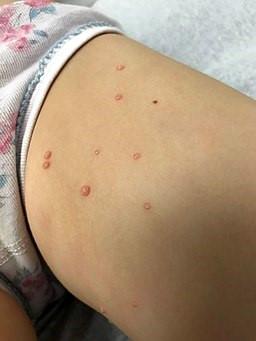Molluscum contagiosum
Peer reviewed by Dr Colin Tidy, MRCGPLast updated by Dr Doug McKechnie, MRCGPLast updated 15 Oct 2024
Meets Patient’s editorial guidelines
- DownloadDownload
- Share
- Language
- Discussion
Molluscum contagiosum is a common condition where small warty bumps (mollusca) appear on the skin. It is caused by a virus that can be passed on by skin contact or from contaminated towels, flannels, soft toys, etc. It is not serious and usually clears within 12-18 months without any treatment.
In this article:
Continue reading below
Molluscum contagiosum causes
Molluscum contagiosum is a type of skin infection caused by a virus, which can be passed on by skin-to-skin contact. People can also be infected by touching things that have been contaminated by the virus. For example, by sharing towels, flannels or soft toys that have been used by someone who has molluscum contagiosum.
Once one area of skin is affected, the rash can spread to other areas of the skin. However, most people are resistant (immune) to this virus. Therefore, most people who come into contact with affected people do not develop molluscum contagiosum.
Molluscum contagiosum in adults
In adults, sometimes the virus is passed on during close skin-to-skin contact when having sex. If it is passed on through sexual contact then the first mollusca to appear tend to be on the skin of the lower tummy (abdomen) and in the genital area: around the penis, vagina or back passage (anus).
If this happens, it's a good idea to get checked for other sexually transmitted infections. You can attend a genitourinary medicine (GUM) clinic for tests and do not need a referral from your GP.
People with a weakened immune system
People whose immune systems are not working as well as usual are more likely to get molluscum contagiosum. (For example, people with AIDS, or people who are having chemotherapy or steroid treatment.)
In people with a weakened immune system, areas of molluscum contagiosum might be larger or spread widely over the body.
Who gets molluscum contagiosum?
Molluscum contagiosum in kids
Molluscum contagiosum can affect anyone of any age. It is most common in children and mostly happens in children aged 1-4 years. However, it can also (much less commonly) affect adults.
Continue reading below
Molluscum contagiosum symptoms
Molluscum contagiosum causes small lumps (mollusca) on the skin, which are pearly-white or slightly pink.
Each lump (molluscum) looks like a small swelling on the skin and is round, firm and about 2-5 mm across.
A tiny dimple often develops on the top of each molluscum.
If you squeeze a molluscum, a white cheesy fluid comes out.
Most people have fewer than 30 mollusca.
Molluscum contagiosum

Gzzz, CC BY-SA 4.0 , via Wikimedia Commons
Sometimes many mollusca develop over various parts of the skin. They tend to occur in groups or clusters. Any part of the body can be affected but it is rare on the palms and soles.
Molluscum contagiosum stages
The small lumps (mollusca) on the skin usually develop 2-8 weeks after becoming infected with the virus. Typically, each lump (molluscum) lasts a few weeks or months, crusts over and then goes.
However, new ones tend to appear as old ones are going, as the virus spreads to other areas of skin. Therefore, crops of mollusca may appear to come and go for several months.
For some people, the main concern is that the mollusca can look unsightly. Most children are not bothered by it.
How long does molluscum contagiosum last?
It commonly takes 12-18 months before the last of the mollusca goes completely. Occasionally, the condition lasts longer than two years - sometimes as long as five years.
Continue reading below
Molluscum contagiosum treatment
No treatment
It's usually best not to treat molluscum at all, particularly in children.
This is because:
The small lumps (mollusca) on the skin will usually go away without treatment within 12-18 months. Children with molluscum contagiosum can still go to school, do sports, swim, and all of their usual activities.
Many of the treatments can be painful and distressing (such as liquid nitrogen).
Some treatments have a risk of burning the surrounding skin.
All treatments have a small risk of scarring the skin. Scarring rarely occurs if the mollusca are left to go away on their own.
There is no really good evidence that any treatment makes a big difference to how long the mollusca last.
Treatment options if needed
There is no convincing evidence yet that any one treatment works best.
Sometimes treatment is wanted, if the lesions are particularly unsightly or troublesome, or if they are spreading very widely. You should discuss this with your GP.
Treatment options include:
Freezing the mollusca with liquid nitrogen (cryotherapy).
Scraping the mollusca off, using a sharpened spoon-shaped tool (curettage).
Creams and lotions may be used. Currently, we don't know which is the best one, or even if some of them have any effect at all. Options used include:
Benzoyl peroxide.
Hydrogen peroxide.
Potassium hydroxide (sold in the UK over-the-counter as MolluDab® or Molutrex®).
Salicylic acid.
Iodine preparations.
Podophyllotoxin cream.
Imiquimod cream. (Prescribed occasionally by skin specialists, particularly in people who have problems with their immune system.)
Pulsed dye laser therapy. (Blasting the mollusca with special laser beams. Occasionally used by skin specialists.)
If the skin around the mollusca becomes itchy or infected, your GP can prescribe creams for this.
Is molluscum contagiosum serious?
Molluscum contagiosum is usually harmless.
The small lumps (mollusca) on the skin are not usually itchy, painful, or serious. A scar is not usually left when they go but sometimes a tiny dent or mark remains. In a few people the skin looks lighter in the places where mollusca have been.
In people with eczema (atopic dermatitis), molluscum can trigger an eczema flare. Molluscum can also cause an eczema-like reaction (
Occasionally, the skin next to a lump (molluscum) becomes infected with germs (bacteria). This can be treated with antibiotic creams or medicines. Rarely, a molluscum on an eyelid causes eye inflammation. (See a doctor if any eye symptoms develop related to a molluscum.)
After an episode of molluscum contagiosum has cleared away, people are normally then immune to the virus, meaning it's very unlikely to come back.
If you develop a very large number of mollusca (hundreds) or the mollusca are larger than normal, it could be a marker of an underlying problem with your immune system, which might require further tests.
How to prevent molluscum contagiosum
The chance of passing on the molluscum contagiosum virus to others is small, and it is not serious anyway. Therefore, there is no need to keep children with molluscum contagiosum off school, or away from swimming pools, etc. There is no need for adults to keep away from gyms or other people.
To reduce the chance of spreading the virus to others:
Don't share towels, clothes, soft toys, or bathwater if you have molluscum contagiosum.
Avoid skin-to-skin contact with other people (for example, by covering affected areas with clothing).
A condom should be used during sex. This will not completely stop skin-to-skin spread but will reduce the chance of passing it on considerably.
Try not to scratch the mollusca, as this may increase the risk of spreading the rash to other areas of the skin. Molluscum contagiosum can be passed on to other people (is contagious) until the last lump (molluscum) has gone.
Patient picks for Skin infections

Infections
Warts and verrucas
Warts are usually harmless but may be unsightly. Warts on the feet are called verrucas (or verrucae) and are sometimes painful. Warts and verrucas usually clear in time without treatment. If required, they can often be cleared more quickly with treatment. Most commonly, treatment involves applying salicylic acid or freezing with liquid nitrogen or a cold spray.
by Dr Doug McKechnie, MRCGP

Infections
Scabies
Scabies is a very itchy skin infestation caused by a tiny mite. It is spread by close contact, such as living with someone or sharing a bed.
by Dr Toni Hazell, MRCGP
Further reading and references
- Molluscum contagiosum; DermNet NZ
- Molluscum contagiosum: images; DermNet NZ
- Basdag H, Rainer BM, Cohen BA; Molluscum contagiosum: to treat or not to treat? Experience with 170 children in an outpatient clinic setting in the northeastern United States. Pediatr Dermatol. 2015 May-Jun;32(3):353-7. doi: 10.1111/pde.12504. Epub 2015 Jan 30.
- van der Wouden JC, van der Sande R, Kruithof EJ, et al; Interventions for cutaneous molluscum contagiosum. Cochrane Database Syst Rev. 2017 May 17;5:CD004767. doi: 10.1002/14651858.CD004767.pub4.
- Molluscum contagiosum; NICE CKS, March 2022 (UK access only)
- Fernando I, K Edwards S, Grover D; British Association for Sexual Health and HIV national guideline for the management of Genital Molluscum in adults (2021). Int J STD AIDS. 2022 Apr;33(5):422-432. doi: 10.1177/09564624211070705. Epub 2022 Mar 21.
Continue reading below
Article history
The information on this page is written and peer reviewed by qualified clinicians.
Next review due: 14 Oct 2027
15 Oct 2024 | Latest version

Ask, share, connect.
Browse discussions, ask questions, and share experiences across hundreds of health topics.

Feeling unwell?
Assess your symptoms online for free
Sign up to the Patient newsletter
Your weekly dose of clear, trustworthy health advice - written to help you feel informed, confident and in control.
By subscribing you accept our Privacy Policy. You can unsubscribe at any time. We never sell your data.